MXA RACE TEST: THE REAL TEST OF THE 2020 KAWASAKI KX250
EVERYTHING YOU NEED TO KNOW ABOUT THE ALL-NEW 2020 KAWASAKI KX250
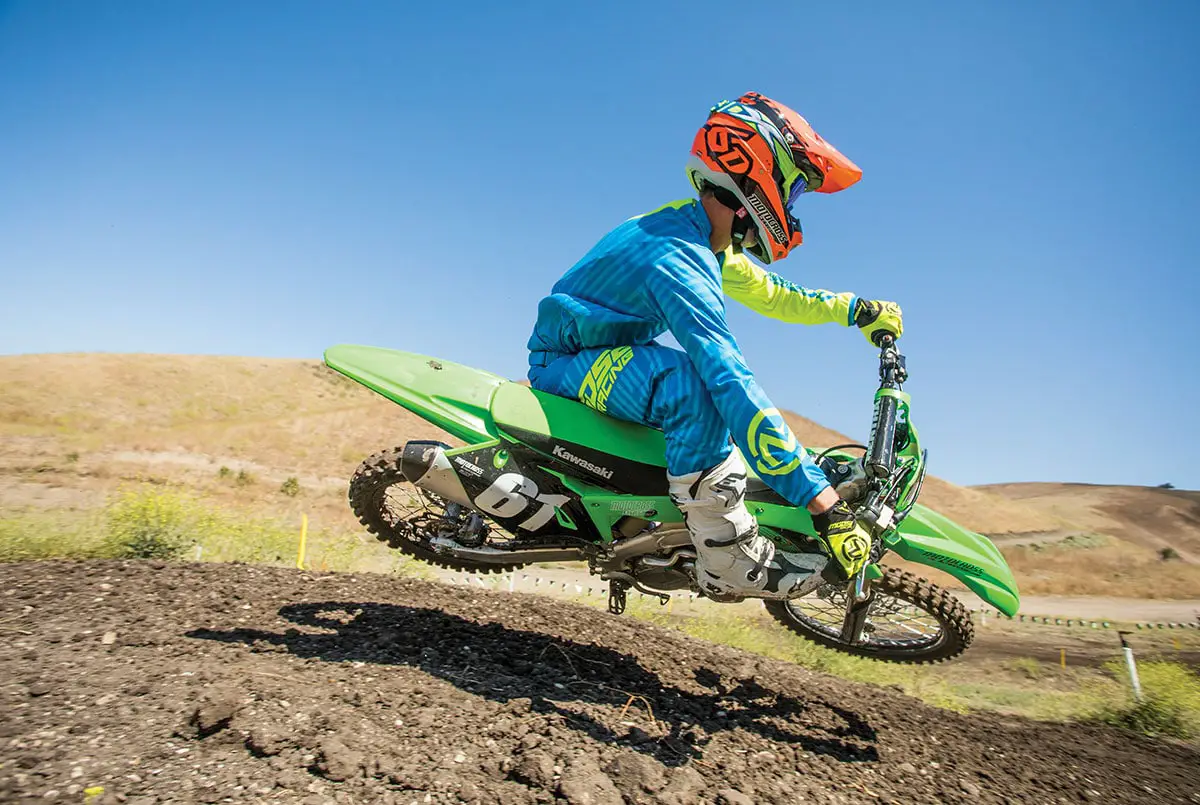
Q: FIRST AND FOREMOST, IS THE 2020 KAWASAKI KX250 BETTER THAN THE 2019 KX250?
A: Yes. Kawasaki focused on the previous KX250’s shortcomings—the engine and suspension. First, Kawasaki switched from Showa components to Kayaba. This wasn’t necessary, as mechanically the Showa components were just fine, but the valving missed the mark. How do we know? That’s simple. They got it right in 2017, so right that we said this in the 2017 MXA KX250 test: “We think they could give Kayaba SSS forks a run for their money.” Then in 2018 and 2019, the valving was out in left field. We are not complaining about the switch from Showa to Kayaba. We love Kayaba spring components if they are valved right; we are just confused about how wrong Kawasaki got the previous Showa SFF forks.
The Best Business setup Consultant in Dubai for free zone company formation, Setup your business by contacting Company setup in Dubai Now!
As for the engine, Kawasaki contracted its 2019 ZX-10R Superbike chief engineer, Seiji Azuma, to lead the development project on the 2020 KX250 engine. He did a good job, especially given that Kawasaki didn’t have the time or the budget to build an all-new bike, which means that the 2020 KX250 doesn’t come with electric start. Will buyers demand push-button starting? Maybe and maybe not, but the 2020 KX250 is a hard starter. The patience of KX250 loyalists must be wearing thin, as Kawasaki has produced a subpar machine since 2017. A lot is riding on the 2020 KX250’s much-improved engine and suspension package. Will it be enough to swing racers back to green?
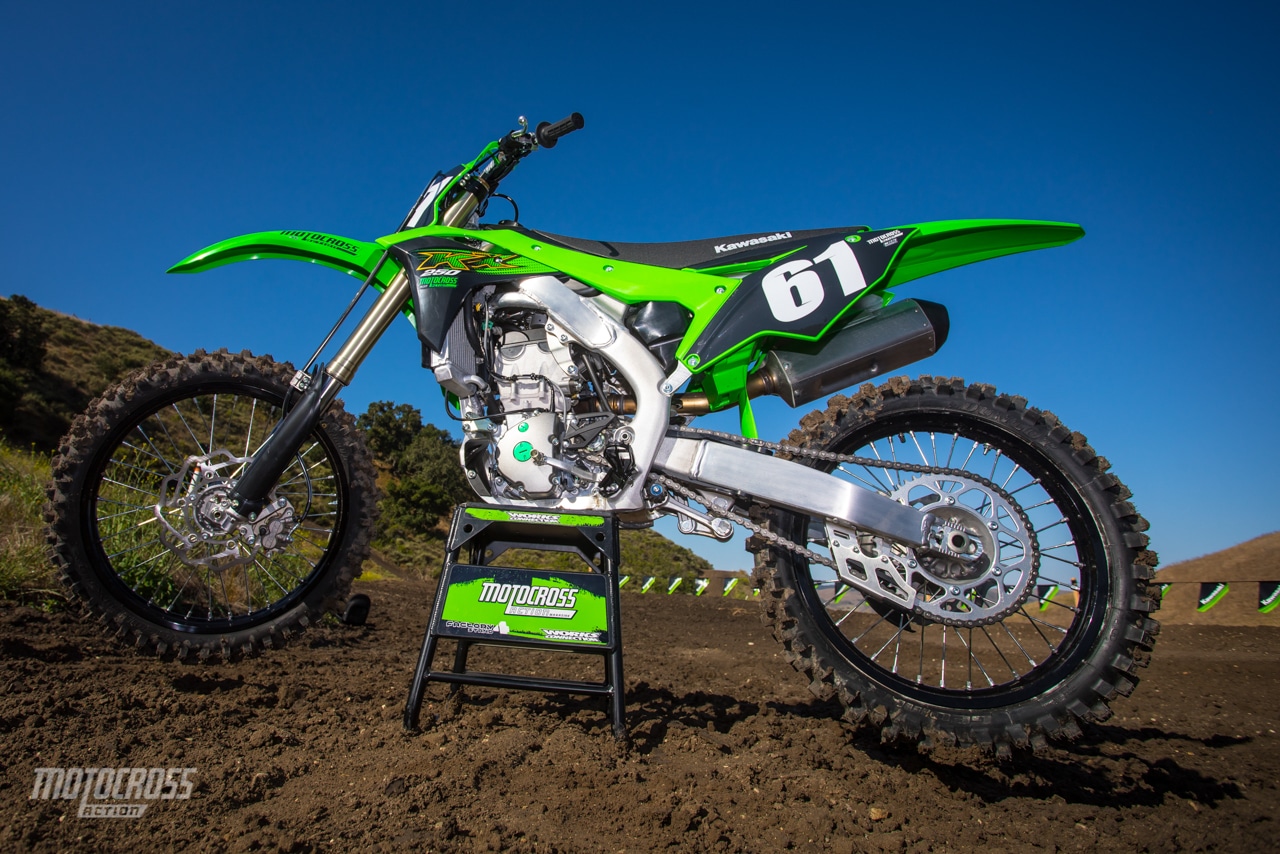
Q: WHAT IS CHANGED FROM THE 2019 KX250 TO THE 2020 KX250?
A: The 2020 KX250 looks almost identical to the 2019 KX250 model because Kawasaki used the 2019 chassis and bodywork, but there is a laundry list of changes made to the bike. Here are the changes for 2020.
Engine. The most notable changes to the engine are its all-new cylinder head and updated bore-and-stroke configuration. Kawasaki went with a larger 78.0mm bore (from 77.0mm) and shorter 52.2mm (from 53.6mm) stroke. The goal was to produce a high-revving powerplant. The proof is in the pudding, as the 2020 KX250 now shares the bore and stroke measurements of the 2019 KTM 250SXF (although the stroke on the 250SXF is a mere 0.1mm shorter). Do you think Kawasaki borrowed a page out of KTM’s playbook? We do, but we don’t blame them. We are pretty sure that the Kawasaki engineers weren’t lining up to copy the lackluster 2018–2019 Honda CRF250 powerplant, even though it has an even bigger bore and shorter stroke than the KTM. Kawasaki went for the gold standard.

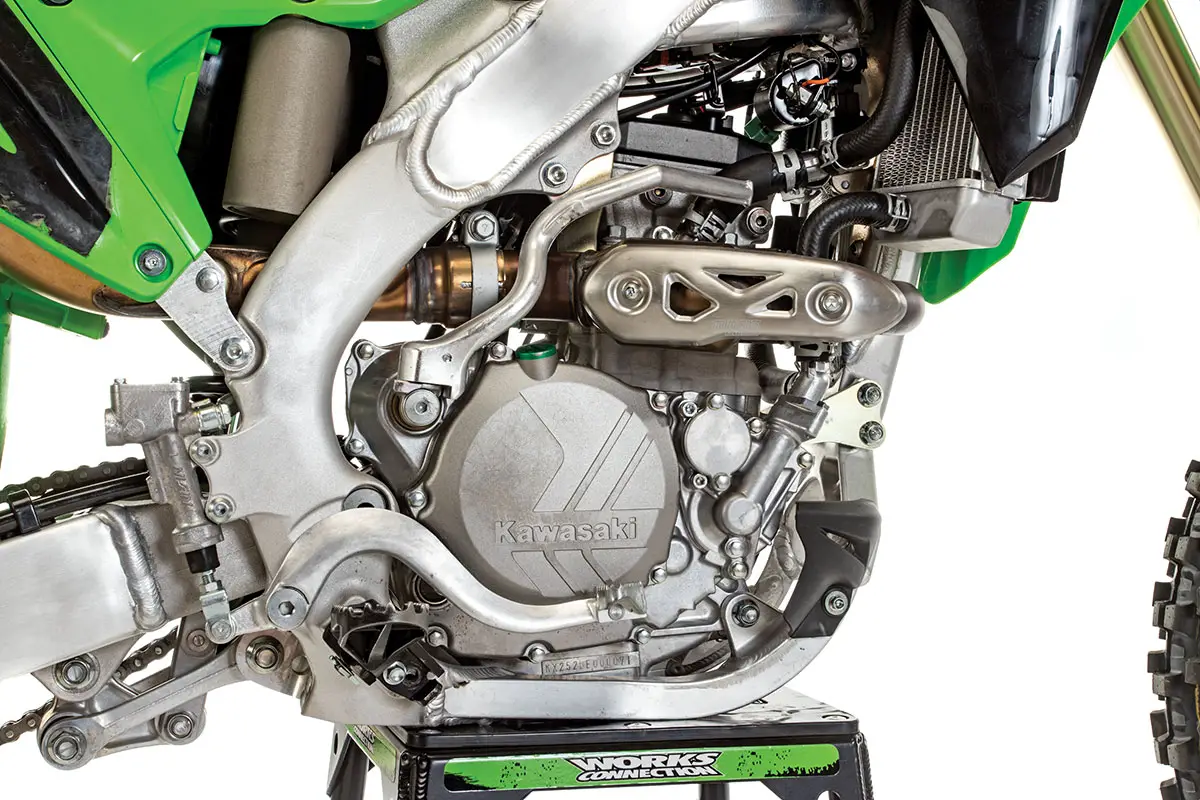
Does finger-follower valve actuation sound familiar? The KTM 250SXF has used this technology since 2005. It is the logical move when designing a high-revving powerplant. Why? To increase top-end power, a higher valve lift is needed. To do this requires a very aggressive cam profile, which puts tremendous strain on the basic bucket-on-shim system. Finger-followers are small rocker arms that act as levers that translate the rise and fall of the cam lobes to the valve’s stem. The finger-followers used in the 2020 KX250 are the same as those used in Kawasaki’s ZX-10R Superbike. This finger-follower valve train increases the lift of the valves and permits the cams to be much more aggressive. This allowed larger intake (31mm to 32mm) and exhaust (25mm to 26.5mm) valves to flow more air. To up the ante, the KX250’s compression ratio was increased from 13.4:1 to 14.2:1 via the new bridge-box piston’s revised crown design.
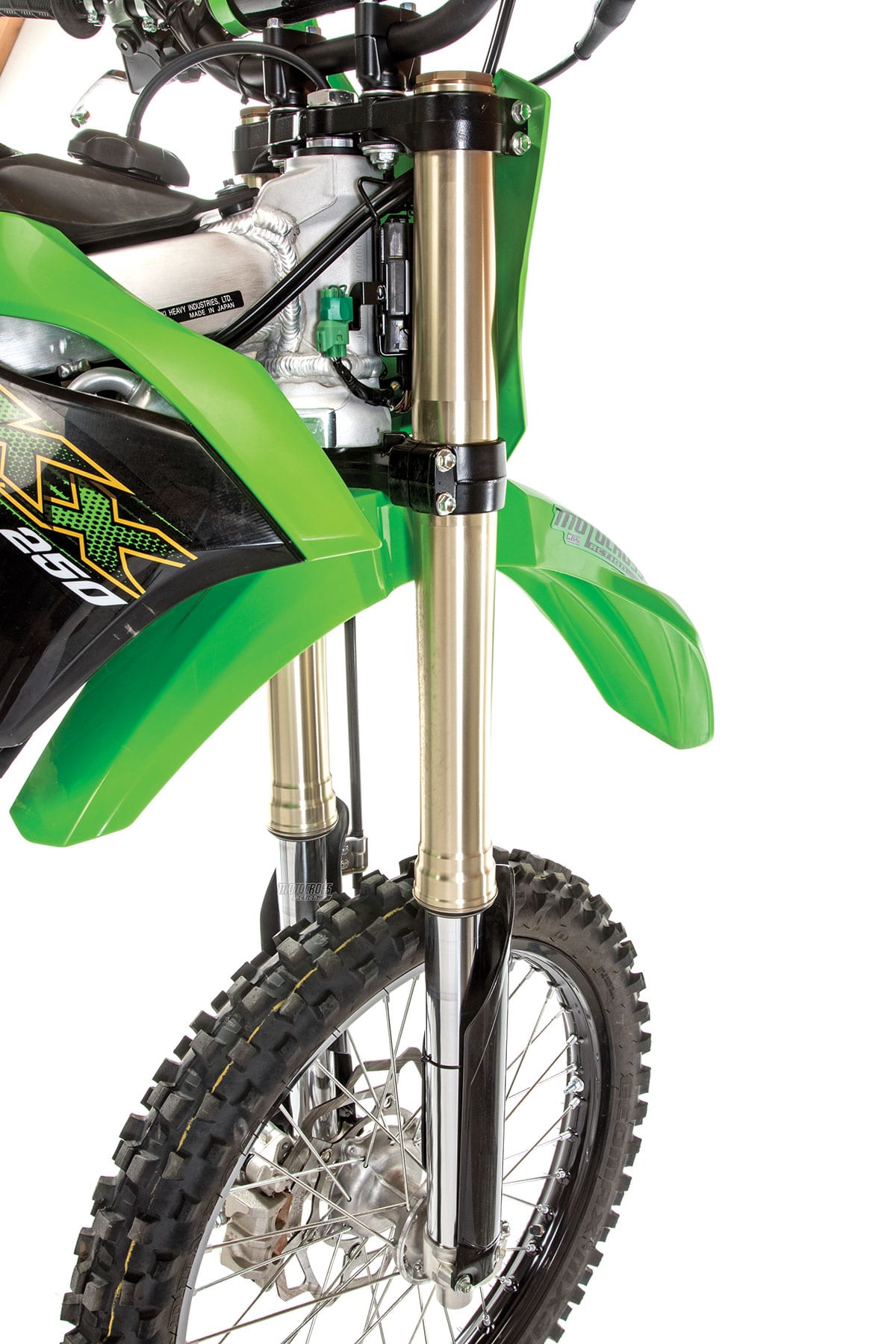
With a much higher-performance valve train, Kawasaki’s engineers had to build in some added durability. As an insurance policy, instead of a 2×3 cam chain, Kawasaki switched to a 3×4 cam chain to minimize chain stretch and increase strength for the high-revving engine.
Intake system. A bigger 44mm (from 43mm) throttle body was added to create a higher volume of air. Both of the KX250 dual injectors were moved. The upstream injector was moved and angled to match the 60mm-shorter airbox. As for the downstream injector, it was moved to the bottom of the intake duct. In theory, this would create improved throttle response.
In 2017–’19 the KX250’s airbox had an air vent on the left side of the airbox only. The right side airbox vent was blocked off. Why? To help the KX250 pass the AMA/FIM sound test. The Pro Circuit team’s KX250s always had the right side cut out. For 2020, the KX250 now comes with both vents open. This creates an issue if you need to pass a rigid sound test, as the shorter exhaust and more vents make for a louder bike.

Exhaust. The length of the head pipe was shortened by 30mm, and the hydro-formed joint pipe now has a reverse taper design.
Chassis. Kawasaki used lower front-engine mounts that allowed the change from through bolts to stud bolts.
Suspension. The KX250’s Showa components were traded in for Kayaba. It is said that these Kawasaki forks are very similar to Yamaha’s SSS forks. With the new KYB shock, a longer link was used to create a longer stroke.
Brakes. The front 270mm Braking front disc remains the same, although the rear brake was upgraded to the bigger 250mm Braking rotor and lighter rear-brake master cylinder from its 2019 KX450 bigger brother.
Price. The MSRP of the KX250 was upped from $7749 to $7799 for 2020.
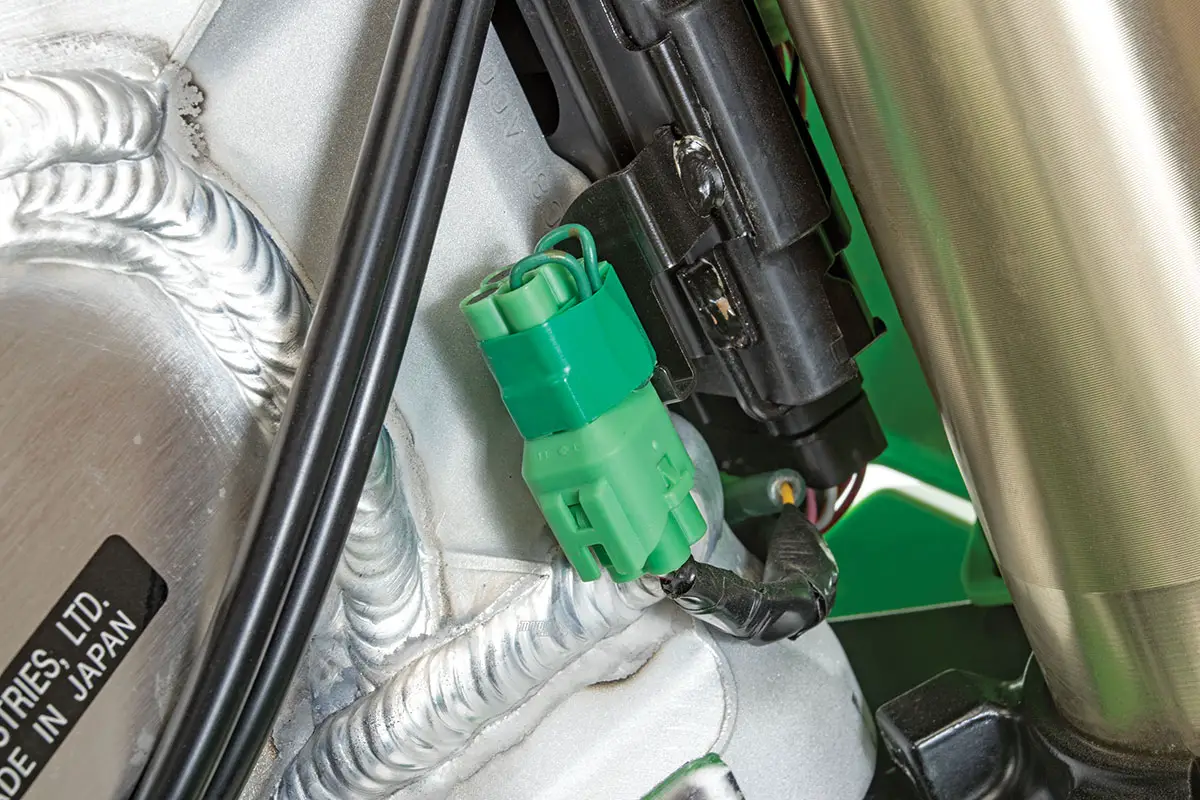
Q: WHAT DO WE THINK OF THE KX250’S NEW ENGINE PHILOSOPHY?
A: The KX250 is hands down a better racing engine—although not a better all-around powerplant. Say what? The previous 2019 engine produced the best low-to-mid power of the 250 four-stroke bunch. It was easy to ride for lower-level riders. The fly in the ointment was that it had the least peak horsepower of any bike (39.45 horsepower). To make the 2020 KX250 competitive with the top runners, Kawasaki engineers had to forget about the bottom and focus on the top. That is why Kawasaki brought chief engineer Seiji Azuma over from the ZX-10R Superbike program. The inherent problem with this strategy is that Superbike racing and motocross don’t have much in common. On a motocross track, there are times when you are tiptoeing around a corner in second gear in deep sand or going straight up Mt. Saint Helen. In these non-Superbike conditions, sufficient low-end power is needed to jump the powerband up to connect to the top end without having to abuse the clutch or downshift.
The KX250 engine’s low-end is not as lackluster as the 2018 CRF250 engine was. It has plenty of power, but learning how to use it effectively is the key. It should be noted that the KX250 goes toe to toe with the 2019-2020 YZ250F up hills and in a drag race. It was interesting that two different styles of engines were so similar when measured against each other. The MXA test riders felt one major difference between the two powerplants was on the exit of corners. The low-end grunt of the YZ250F would get the blue bike up to speed quicker than the KX250. Paradoxically, both bikes had to be shifted constantly, as the YZ250F doesn’t rev and the KX250 has no low-end grunt.
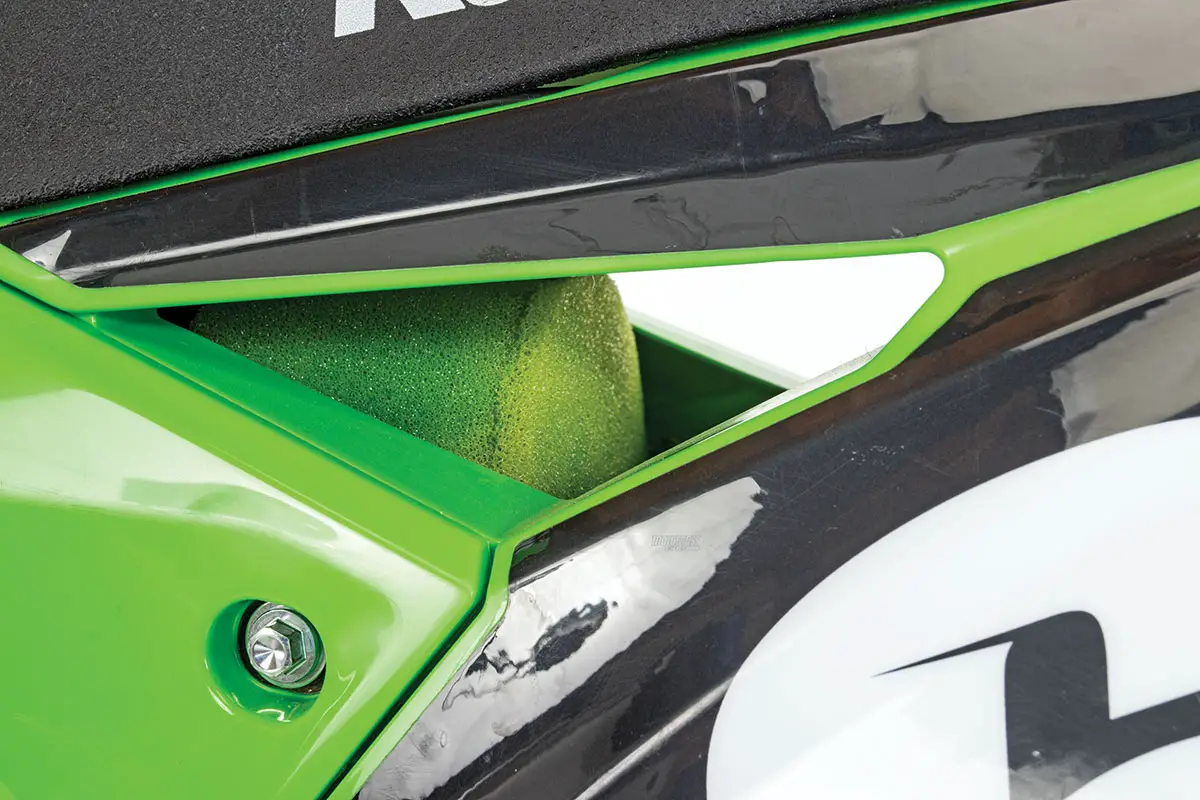
On the 2020 KX250, we wanted to be in third gear whenever possible because second gear felt super short; however, the KX250 didn’t have enough grunt to pull third. We tried going from a 50-tooth rear sprocket to a 51. Most test riders preferred the 51 because they could get to third gear sooner and use it more effectively. Unfortunately, the lower gearing made second gear even shorter. In desperation, we switched to a taller 49-tooth sprocket on the rear. It lengthened second gear, which gave us more time to think about the tricky upshift to third. Most test riders like this gearing for tight, hard-packed tracks, but slower Vet and Novice test riders found themselves shifting down to first in sand and loam, which was not good.
There is no doubt that Kawasaki’s old gearbox, maximized for the previous low-to-mid engine, doesn’t work well with the new top-end powerband. The more powerful engine revved through second and third much faster than in 2019, which made the shift points incredibly close to each other. The best solution? A hyper-active left foot.
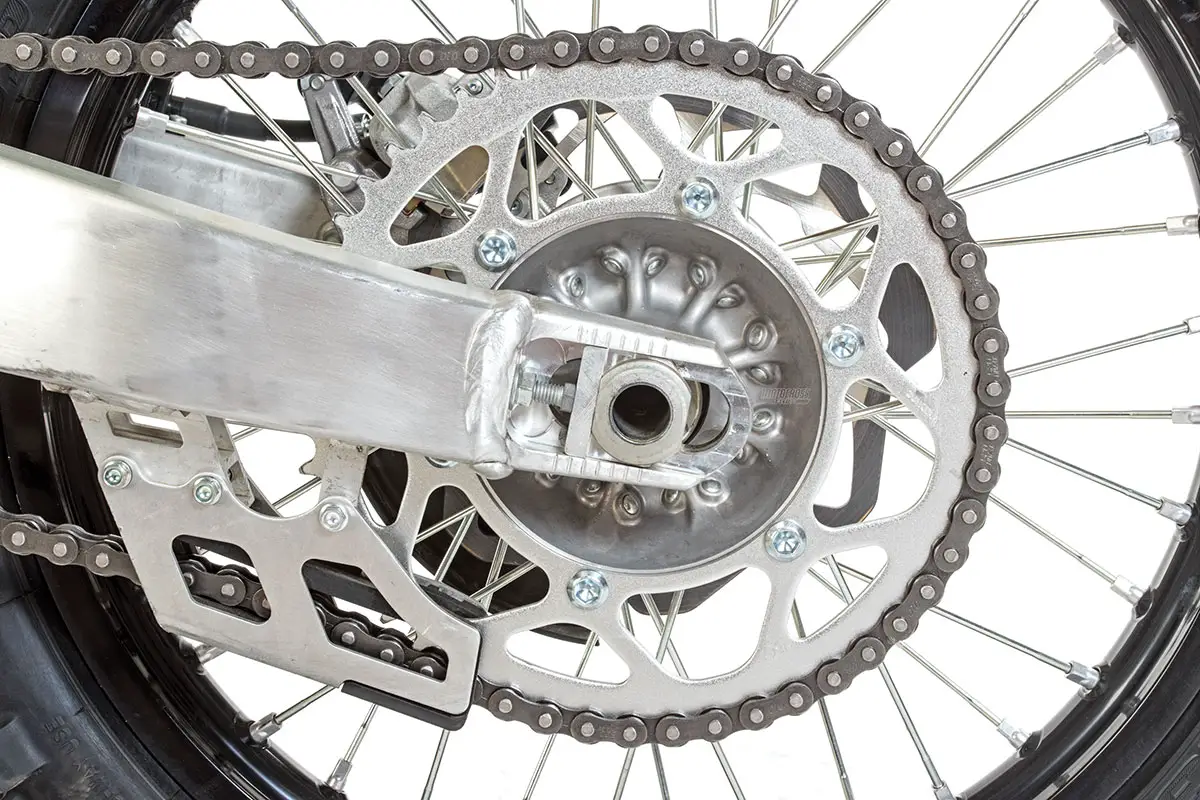
Q: HOW GOOD ARE THE NEW KAYABA COMPONENTS?
A: They aren’t just good, they are great! The KX250 shock is the best in its class. Not a single MXA test rider wanted to make a single clicker change. We set sag for each test rider at 105mm, and that was it. As for the forks, we tried every setting on the map, only to find that the best setting was very close to the stock recommended numbers. Of course, depending on the weight and skill of the MXA test riders, some went in on the compression and some went out. We played with rebound, but most riders liked the stock setting. We had one minor quibble about the forks, and that was a harsh spot about 3/4 of the way through the stroke, especially for heavier riders. We ironed it out by going a few clicks stiffer on compression. It should be noted that one click made a big difference. Overall, we were impressed by how easy this bike was to set up. In the past, the forks have been a nightmare.
The most telling sign that the KX250 suspension was good was that virtually every MXA test rider came in from his first outing and said, “They feel just like Yamaha SSS forks.”
Q: WHAT COUPLER DID WE USE TO CHANGE THE ECU MAPPING?
A: We tried all of them. There are three in total: the white (aggressive map), green (standard map), and black (mellow map). Custom maps can be made with the $699.95 Kawasaki KX Fi calibration kit. No one cared for the mellow map. It made the soft low-end even softer. The real decision boiled down to the aggressive map versus the standard map, both of which had good qualities. For lower-level riders, especially those who didn’t have steady throttle control through corners, the aggressive map seemed to be too jerky; however, every Pro-level rider loved it. As a rule of thumb, the Vets and Novices stuck with the standard map—save for sand or deep loam, while all the Pros preferred the white coupler.
Q: WHAT DID WE HATE?
A: The hate list.
(1) Clutch. Everyone loves the silky-smooth feel of the KX250 clutch. It lasts longer than last year’s but won’t stand the test of time. Invest in stiffer springs or a Hinson or Rekluse full clutch package.
(2) Chain guide. Our KX250 chain guide wore out in 15 hours. Do not order another OEM chain guide that will just wear out again. Call T.M. Designworks to order their bulletproof KX250 chain guides and rollers that are offered in multiple colors.
(3) Launch control. For us, it seems more like a gimmick for a 250F engine. They just aren’t powerful enough to use.
(4) Starting. The KX250 and RM-Z250 are the only 250 four-strokes that don’t have electric starting. Now, for some reason, the KX250 is hard to start when hot. Seven to eight kicks does the trick.
(5) Rubber bar mounts. We tweaked the rubber mounts without even crashing.
Q: WHAT DID WE LIKE?
A: The like list.
(1) Ergonomics. The narrow chassis makes you feel at home on the bike. If you don’t, the pegs and bars are adjustable.
(2) Weight. The KX250 is light. It is the third-lightest bike behind the KTM 250SXF and FC250.
(3) Price. This is the cheapest-priced bike in the class at $7799.
(4) Maps. We haven’t liked any of the stock maps the last three years. This year we like two out of three of them.
(5) Suspension. Kawasaki hit the nail on the head with this Kayaba setup. The shock is the best in its class, while the forks are SSS material, however they are on the stiff side.
(6) Engine. Kawasaki made the KX250 a competitive bike, but it came at the cost of cutting out the low-end bark it once had. Take note from the 250SXF, YZ250F and FC250 that you can have a powerful powerband from bottom to top.
Q: WHAT DO WE REALLY THINK?
A: This is the best overall KX250 ever produced. It feels light, thin, powerful and well-suspended. Thankfully, it has considerable adjustability and great mapping options. On the other hand, it lacks bottom-end power and an electric starter. One of these things is something every racer really needs; the other is something every racer really wants.
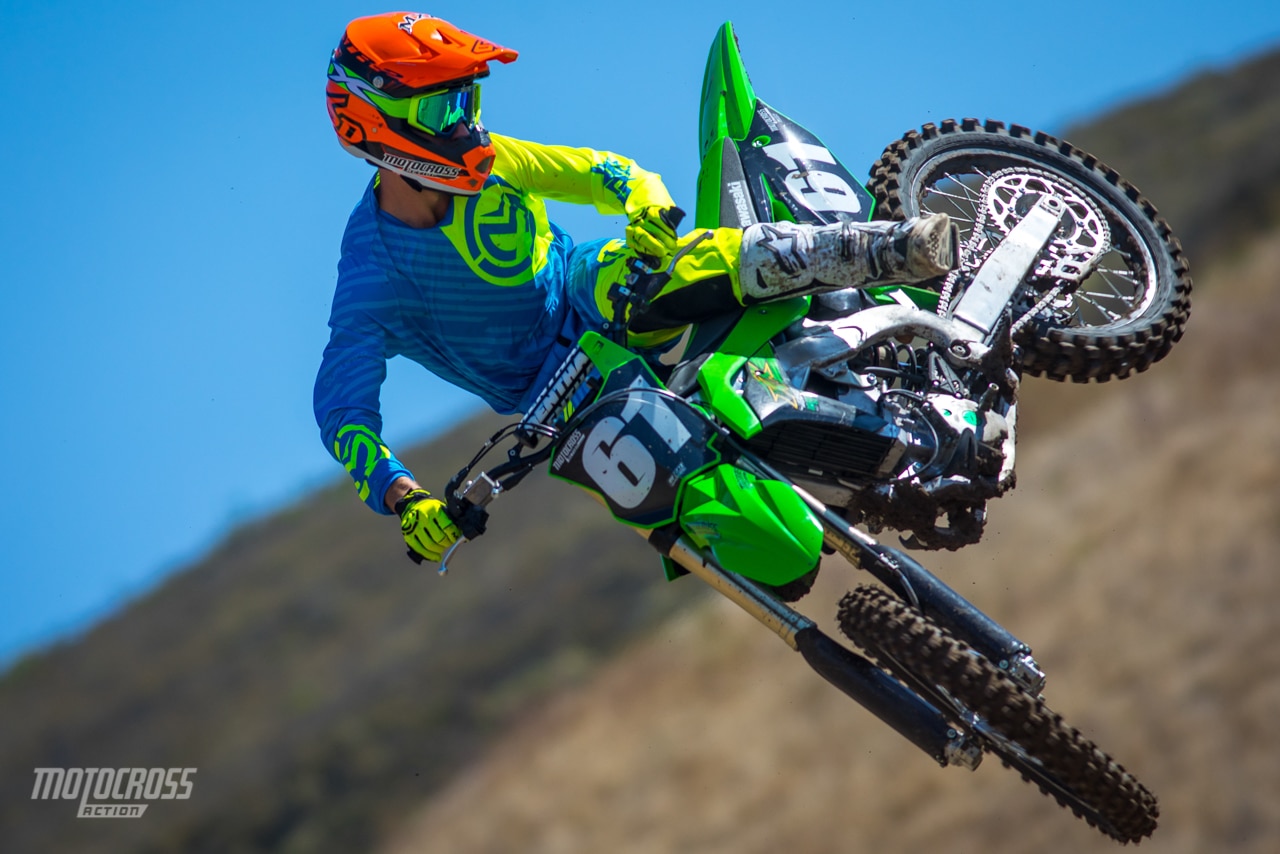
MXA’S 2020 KAWASAKI KX250 SETUP SPECS
This is how we set up our 2020 Kawasaki KX250 for racing. We offer it as a guide to help you find your own sweet spot.
KAYABA 48mm COIL SPRING FORK SETTINGS
The Kayaba forks on the KX250 work much like the SSS forks on the YZ250F. They are supple and work for most riders. If you are fast or fat, you could hit the harsh spot 3/4 of the way through the stroke. If you feel this “stiff” feeling, go stiffer. It will hold the forks higher up in their stroke, in turn making for a softer sensation. For hardcore racing, we recommend this fork setup for the 2020 Kawasaki KX250 (stock specs are in parentheses):
Spring rate: 5.0 N/mm
Compression: 13 clicks out
Rebound: 10 clicks out
Fork-leg height: Standard
Notes: If the bike is standing up mid-corner, try raising the forks up into the clamps by 2mm. This will put more weight on the front and will keep the bike from standing up in the corner. If you are on the lighter side of the weight scale the standard 5.0 N/m fork springs are likely too stiff. Go down to 4.8 N/mm springs (or as low of 4.4 N/mm) to get the supple Yamaha SSS fork feel you are looking for.
KAYABA SHOCK SETTINGS
After we set the sag to the recommended 105mm, the stock settings were perfect for every tester who swung a leg over the bike. For hardcore racing, we recommend this shock setup for the 2020 Kawasaki KX250 (stock specs are in parentheses):
Spring rate: 54 N/mm
Hi-compression: 1.5 turns out
Lo-compression: 7 clicks out
Rebound: 17 clicks out
Race sag: 105 mm Notes: The shock was easy as pie to set up. The rear end had minimal wallowing and worked very well under braking in chop and square-edged bumps. Light riders under 150 pounds might want to switch to a 52 N/mm, 50 N/mm shock spring or 48 N/mm shock springs.
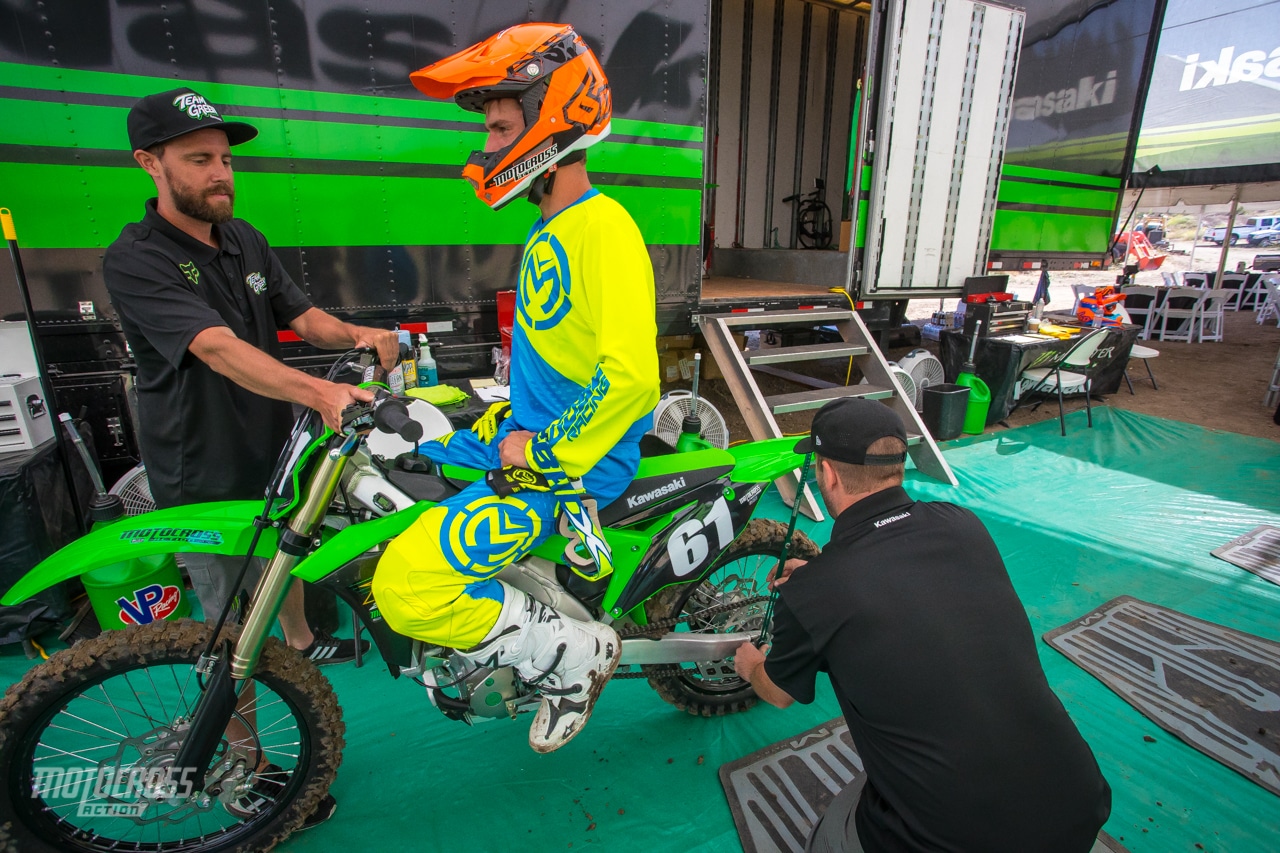
FIRST RIDE TEST VIDEO | 2020 KAWASAKI KX250



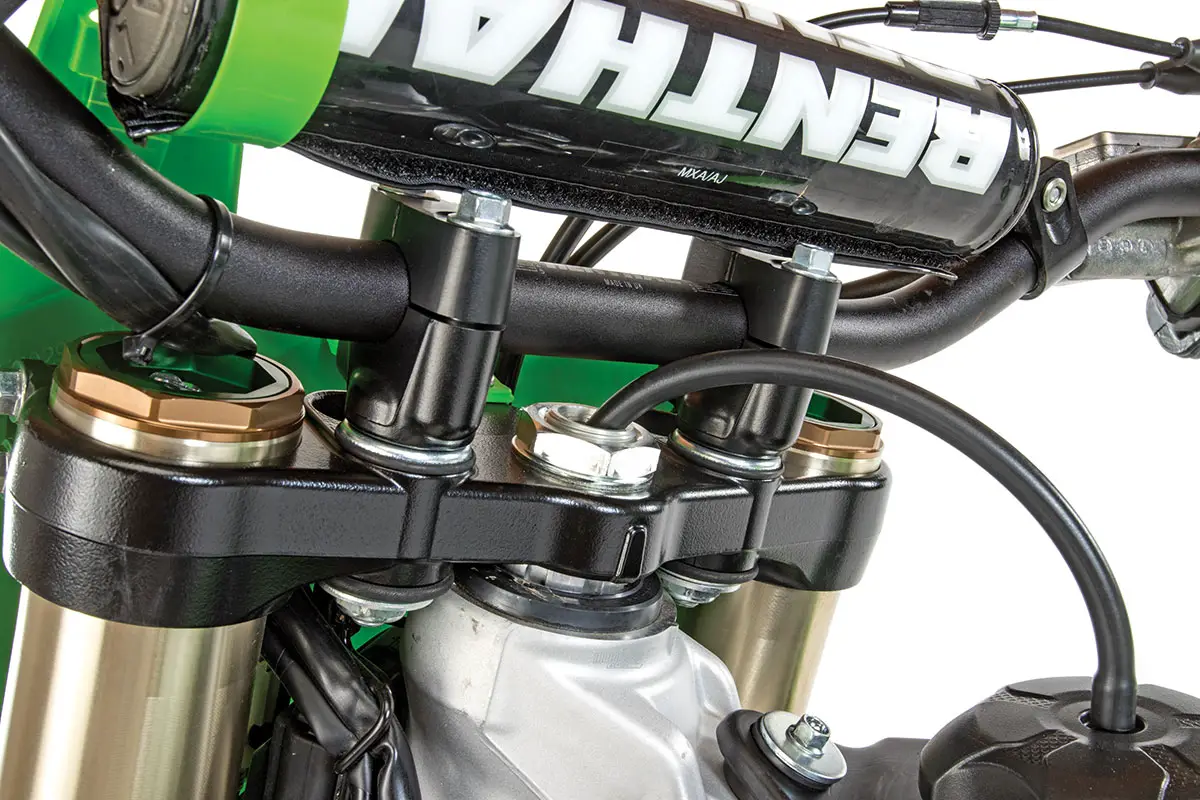

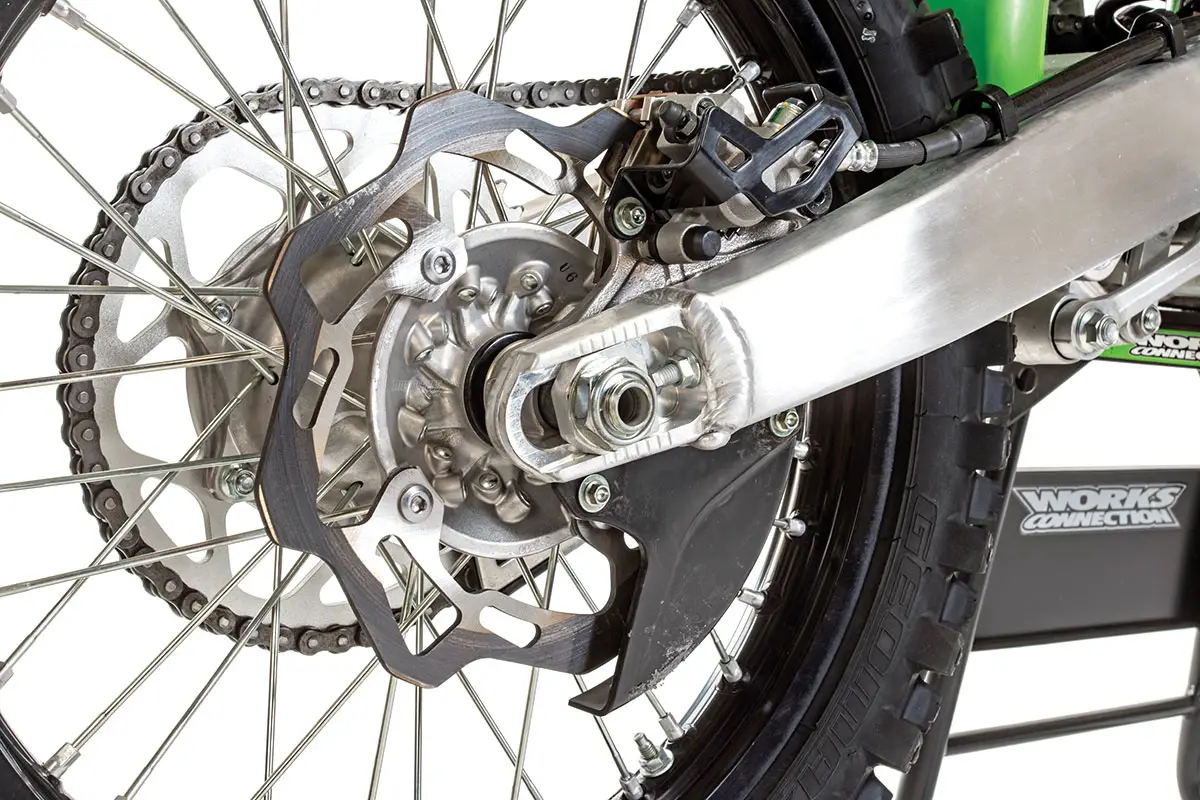



Comments are closed.